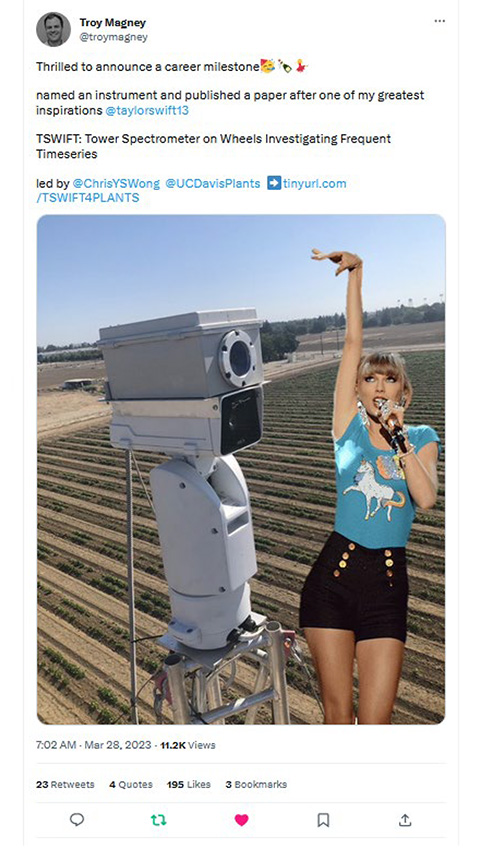
Taylor Swift becomes a phenotype monitoring machine
Magney names remote sensing instrument after pop icon
Taylor Swift: A cultural icon, controversial TicketMaster name, and now a remote phenotype monitoring machine.
And a phenotype, for most of us who wouldn't know, is the science-y word for the physical traits that any living thing would have, such as green leaves or a fabulous voice - the physical expressions of the thing's genes mixed with its environmental influences.
Troy Magney thinks about phenotypes a lot in his work to measure and monitor the ever-changing physical traits of crops. The assistant professor in the UC Davis Department of Plant Sciences also is a Swiftie to his core. After listening to Swift’s album Folklore on repeat while he was coding and building the phenotype monitoring instrument in his lab, naming his machine after the singer-songwriter was a natural step.

Tower Spectrometer on Wheels for Investigating Frequent Timeseries, or TSWIFT, is a 100-foot tower that looms over a field and collects data on plant performance. A recent publication, led by lab-member Christopher Wong, highlights TSWIFT’s potential.
(Bonus points if you can find the nine Taylor Swift song and album references!)
Watch you breathe in, watch you breathing out
TSWIFT effectively allows scientists to watch plants “breathe,” according to Magney.
Magney and his Fearless team within the UC Davis Plant Optics Lab use TSWIFT to monitor hyperspectral reflectance — or how plants reflect light — by measuring the photons that come off the plants. The way plants reflect light tells scientists how much photosynthesis the plants are doing, how much stress they are under, and how they grow — all on an hourly timescale.
Because TSWIFT continuously collects this data throughout the Daylight and across seasons, it overcomes the time and labor limitations that typically impact remote sensing instruments. Truly a Mastermind.
TSWIFT can inform a wide range of studies — from photosynthetic performance to identifying plant varieties more resilient to stressors like drought, climate change, and increasing food crop demands.
Wildest dreams
But what about Taylor Swift? Unfortunately, she does not know that she has a scientific instrument named after her. But if one day she does, it would be a “dream come true” said Magney: “The pinnacle of my career.”
However, TSWIFT isn’t his Debut project, or even his only project named after pop queens. There’s also BEYONCE, CARDI-C, GAGA, and he’s currently working on a MILEY. Magney seems to have a Reputation for his work.
“While we take our science seriously, it’s important for people to remember there’s a human side to this, too, and that we like to have fun,” said Magney.
Well Taylor, we hope you know the plant sciences world knows you All Too Well.
Malia Reiss is a science news intern with UC Davis Strategic Communications. She studies environmental science and management at UC Davis.
Media Resources
- Kat Kerlin, UC Davis News and Media Relations, (530) 750-9195, kekerlin@ucdavis.edu
This version edited by Trina Kleist. This article was first published April 11 on the UC Davis News blogs website.
